The short answer is yes and a more specific answer is that Stainless Steel Cookware will work on Induction Cooktops if it is made with a magnetic grade of stainless steel.
What type of Stainless Steel work with induction Cooktops?
As Stainless Steel can be made with various metals, there are a few things to keep in mind when selecting cookware for your induction cooktop. Not all stainless steel is created equal. In order for your cookware to work on an induction cooktop, it must be made with a magnetic grade of stainless steel.
I used an induction cooktop for 5 years before I moved to my new place. During that time I spent a lot of time researching on Induction compatible cookware and also experimented with different brands.
In this guide, I will discuss:
- Food Grade and Magnetic Grade Stainless Steel
- How does Stainless Steel work on Induction and how to test if the stainless steel cookware is induction compatible?
- Different Stainless Steel Induction Cookware materials and choosing the best one.
- Why cook with stainless steel? and its effects on health.
- How does Induction work and what to do if your favorite pot is not induction compatible?
So What is the Magnetic Grade of Stainless Steel?
The magnetic grade of stainless steel is determined by the amount of ferrous metal (iron) that is present in the alloy. The more iron, the more magnetic the stainless steel will be.
Food Grade Stainless steel Types
There are 3 food grades of stainless steel that are commonly used:
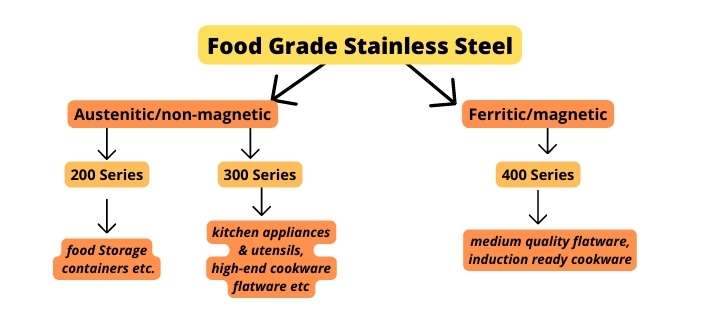
200 series- Austenitic/non-magnetic
It’s the cheapest stainless material and is frequently utilized in low-cost cookware. It contains manganese instead of nickel since it is less expensive, but it isn’t as corrosion-resistant. It isn’t magnetic, either.
300 series- Austenitic/non-magnetic
The most famous variety of stainless steel in cookware. The 304 and 316 series both contain 18/10 or 18/8 chromium and nickel percentages, respectively.
The main distinction is corrosion resistance, however, in most normal kitchens, there isn’t enough humidity or salt water to make a difference.
400 series- Ferritic/magnetic
The 400 series is 18/0 or nickel-free. The 430 series is the most popular choice for induction cookware as it provides a good balance of heat conductivity, corrosion resistance, and magnetic properties.
400 series is not as corrosive resistant as the 300 series.
How does stainless steel work on induction?
The ferromagnetic property of steel cookware is what makes it work on an induction cooktop. When placed on an induction cooktop, the cookware generates a magnetic field.
This in turn creates an electric current in the cookware which produces heat. The heat is then transferred to the food, cooking it in the process.
But How will I know if my Stainless Steel Cookware will work on Induction Cooktop?
If you are unsure if your stainless steel cookware will work on induction, there is an easy way to find out.

Look For Induction Symbol
The induction symbol, which is a horizontal coil, is the most straightforward indicator that your cookware will operate on induction. Some have “induction” imprinted on them. This symbol can be at the bottom of the pan or on the packaging.
Magnet Test for Induction Compatibility
The easiest way to test if your stainless steel cookware is compatible with your induction cooktop is to use a magnet.
Take a refrigerator magnet and hold it up to the bottom of the pan.
If the magnet sticks, then your pan is compatible with induction cooking. If the magnet does not stick, your pan is not made with a magnetic grade of stainless steel and will not work on an induction cooktop.
Stainless Steel Induction Cookware Materials
Stainless Steel itself is a poor conductor of heat. For this reason, it is often combined with other metals that are good conductors of heat, such as copper or aluminum.
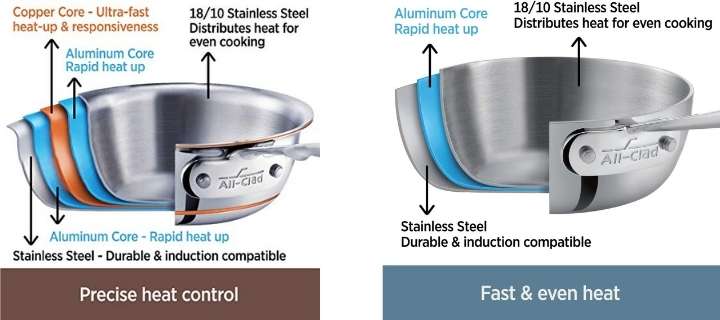
The Stainless Steel Cookware that is induction ready usually has a tri-ply or 5-ply clad construction. In Induction ready 3-ply stainless steel cookware a layer of aluminum or copper is sandwiched between two layers of stainless steel.
Read this article to know about the benefits of tri-ply stainless steel.
The aluminum or copper conducts heat evenly across the bottom and sides of the pan. The inner layer of stainless steel provides a durable, non-reactive surface for cooking, while the outer stainless steel layer is magnetic and induction compatible.
5-ply stainless steel has an additional layer of aluminum or copper in the middle. This results in even better heat conductivity but is also more expensive.
Choosing the best Stainless Induction Cookware
When choosing the best stainless steel induction cookware for your needs, there are a few things to keep in mind.
- Check what size cookware you need. Induction cooktops come in various sizes, so it’s important to choose a pan or pot that will fit on your particular cooktop. Using cookware with a smaller bottom diameter than the induction hob creates a weaker magnetic field and less electricity and heat output.
- Choose wide, flat bottoms because they will make the most efficient use of the heat generated by your cooktop. Check flatness by rotating a ruler or level across the surface of the pan. If there is any wobble, it’s not flat enough.
- Decide what type of stainless steel you need. If you are looking for the best heat conductivity, choose a pan with a 5-ply construction. If you are on a budget, a 3-ply pan will still work well.
- The finest induction cooktop lids are sturdy enough to endure vibration and stay in place if the pan and its contents are boiling hot.
- It’s essential to have comfortable, heat-resistant handles that don’t get hot.
- Look for “induction-ready cookware” or “induction cooktop cookware” when purchasing online.
With these factors in mind, you’ll be sure to choose the best stainless steel induction cookware for your needs.
Why Cook with Stainless Steel?
Stainless Steel is 100% recyclable and is a “green” choice for cookware.
Stainless steel is a popular choice for cookware because it is durable and easy to care for. Multi-Clad Stainless steel is a heat-conductive, corrosion-resistant metal that heats quickly and uniformly. Stainless steel cookware comparatively doesn’t react with acidic foods, so the only flavors you taste are those added during cooking.
Your stainless steel pans will not rust or stain if properly used and maintained. Make sure not to use steel wool or other harsh cleaners on your stainless steel cookware, as this can damage the surface.
Induction-ready stainless steel cookware can also be used on electric and gas stovetops.
Health Effects of Cooking in Stainless Steel
Unfortunately, all stainless steel pots can leach metal into your food. Study shows that Cooking acidic foods will make the pot leach more metal.
Nickel leaches in higher amounts than other metals, so if you have a nickel allergy, you might need to avoid stainless steel altogether.
When buying stainless steel cookware, try to avoid the 200 series. It corrodes easily and is not as durable as other types of stainless steel. The 300 series is the most common and considered the most durable; it also has higher levels of nickel.
Even though the 400 series is said to be less durable than the 300 series, its negligible amount of nickel makes it the safest choice.
How Does Induction Cooking Work?
Induction cooking uses a magnetic field to heat up food. An induction cooker has an electromagnetic coil below the cooking surface. When an inductive cookware pot or pan is placed on the cooking surface, the coil creates a magnetic field.
The magnetic field interacts with the metal in the cookware and causes it to heat up. The cookware then transfers this heat to the food.
Because the heat is generated directly in the cookware, induction cooking is very efficient.
Induction Disks
If you have stainless steel cookware that is not induction-ready, you can still use your non-induction cookware on an induction cooktop with induction disks. Although it would not be as efficient.
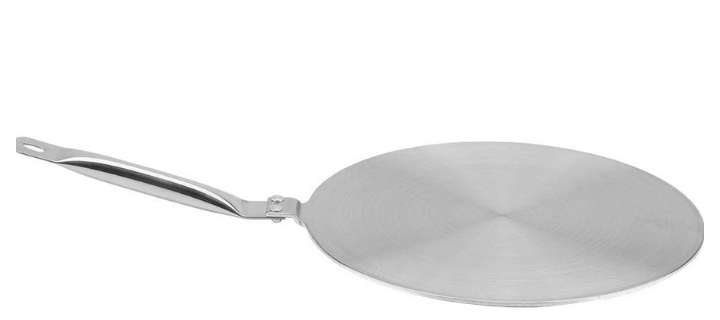
Bottom Line
Stainless steel cookware is a great choice for induction cooking. It is durable, easy to care for, and has a long lifespan.
When choosing stainless steel cookware for induction cooking, make sure to choose a pan or pot which is magnetic and has a flat bottom, heavy lid, and, comfortable, heat-resistant handles.
Finally, be aware of the health effects of cooking in stainless steel and if you have nickel allergies then avoid it altogether
FAQs
Will Stainless Steel Woks work on Induction?
The magnetic field drops rapidly with distance from the surface of the induction cooktop. Stainless Steel Woks with round bottoms will not work on induction. Induction ready Stainless Steel Wok with a flat bottom is best for induction cooking
Will 18/10 stainless steel work on an induction cooktop?
The 18/10 stainless steel alloy is non-magnetic and will not work on an induction cooktop. It contains 18% chromium and 10% nickel.
Will 304 stainless steel work with induction?
The 304 stainless steel alloy is non-magnetic with (18/10) chromium and nickel percentages and will not work with induction cooktops.
What is the best grade of stainless steel for induction?
The 400 series has the lowest nickel content (18/0). It is induction compatible and is also the safest choice for those with nickel allergies. The 300 series is the most corrosion-resistant and durable but not induction compatible.

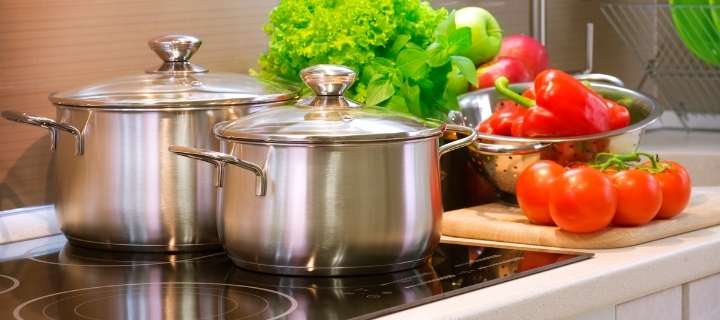

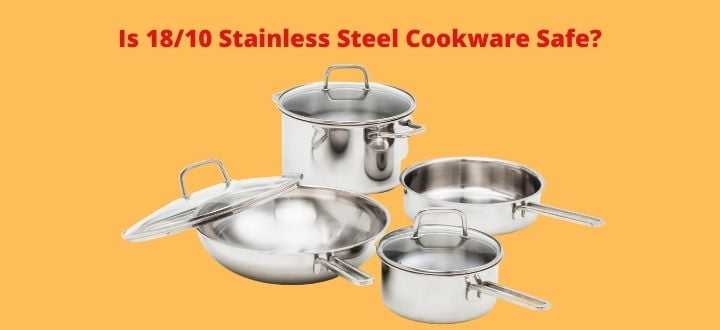

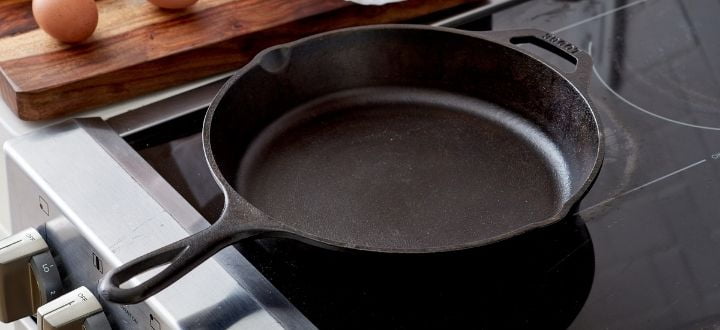
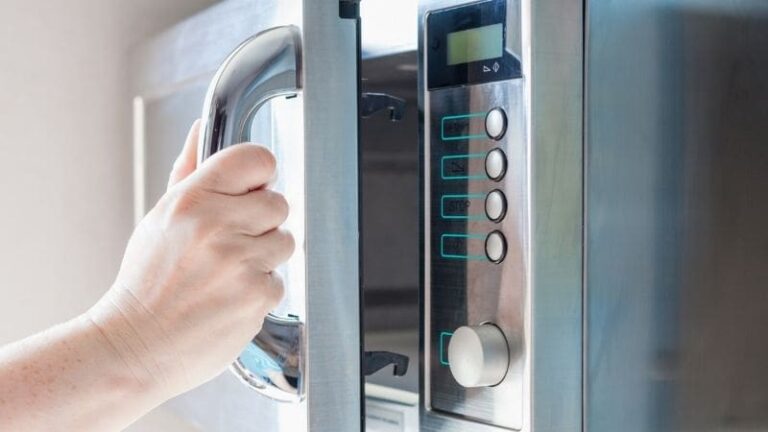
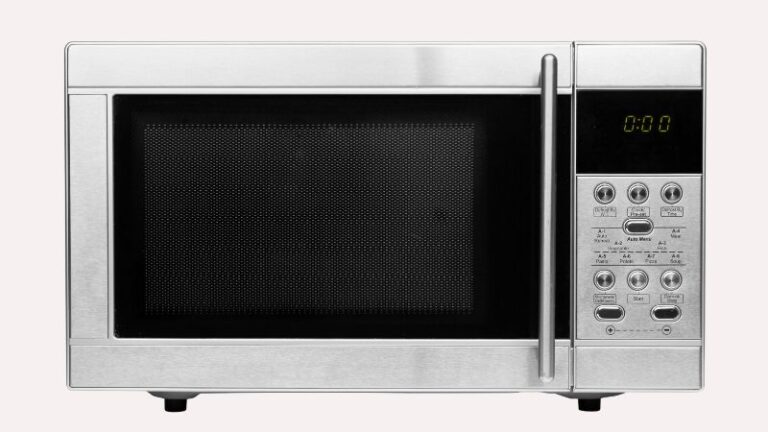
2 Comments
Comments are closed.